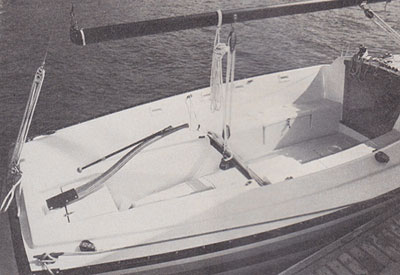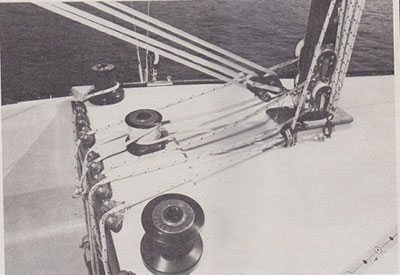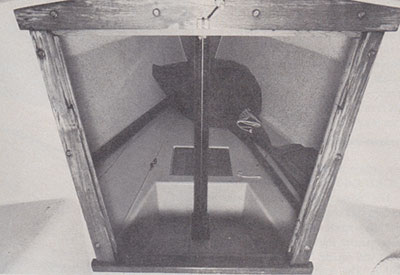Sonar
Bruce Kirby designed a keelboat for one design club racers and family daysailors
Carol Nickle and Bryan Gooderham
In 1979, when Connecticut’s Noroton Yacht Club called out for a spirited, inexpensive, one-design club racer that would be relatively straight-forward and physically undemanding to sail, it was fortunate to have Bruce Kirby as a member. Kirby came up with the 23-foot Sonar. Some 330 Sonars have been built since 1960, and there are now 18 active fleets in New England, the Midwest and Gulf states. The Sonar began production with the Seidelman boat building firm of New Jersey.When Seidelman burned down in 19 81, construction was taken over by another American business, the Ryder Corporation.
In December, 1983, Bruce Kirby and Wally Ross, the owner of the design’s rights, arranged to move construction of the Sonar for the North American market to DS Yacht Sales in Odessa, Ontario, near Kingston. When DS began production of the Sonar, it recognized the American export market as its prime sales target. In 1984 the company built 42 Sonars, eight of which were sold in Canada. DS is optimistic that yacht clubs will encourage the Sonar as a club racer and that sailing 2 schools will find it well-suited to their purposes. As a comfortable, stable and simple day-sailer, it’s also a good boat for family and friends. And to broaden the 60 basic hull design’s market appeal, DS launched the Kirby 23, which has a larger displacement and sail area as well as a proper interior to satisfy cruisers and MORC and PHRF competitors alike.
The Sonar’s design incorporates a modem hull shape with flat bilges, a fin keel and a spade rudder. It features a tall three-quarter fractional rig with a generous 250 square feet of sail area. Says Kirby, “The crucial ratios, such as sail area/displacement and sail area/wetted surface, are well up in the racing boat range … but the flat sections and generous keel give the stability of a little cruiser. ” Because the Sonar is a one-design class, its sail inventory, rigging and equipment are strictly prescribed. Sails are limited to a mainsail, a blade jib and two spinnakers, which keep sail handling simple and eliminates the need for headsail changes.
 The uncomplicated system of sail trim lines and the hardware supplied are generally adequate, and class rules prohibit elaborate or costly alterations. Another popular class regulation is that no hiking is allowed! We were lucky to have a blustery day for our sail test of the Sonar. With no engine, the 20-plus knots of southerly breeze meant we had to tack out of the narrow slip away from the dock, but the Sonar quickly demonstrated its agile maneuverability. Once clear of shore, we enjoyed an exhilarating ride back and forth across Toronto Harbor. Protected by the Toronto Islands, the waters of the bay stayed relatively flat in spite of the lively breeze-ideal conditions for sailing a small, spritely boat like the Sonar.
The uncomplicated system of sail trim lines and the hardware supplied are generally adequate, and class rules prohibit elaborate or costly alterations. Another popular class regulation is that no hiking is allowed! We were lucky to have a blustery day for our sail test of the Sonar. With no engine, the 20-plus knots of southerly breeze meant we had to tack out of the narrow slip away from the dock, but the Sonar quickly demonstrated its agile maneuverability. Once clear of shore, we enjoyed an exhilarating ride back and forth across Toronto Harbor. Protected by the Toronto Islands, the waters of the bay stayed relatively flat in spite of the lively breeze-ideal conditions for sailing a small, spritely boat like the Sonar.
We found it a fun boat to sail: quick, responsive and powerful. It is well-balanced and easy to steer, even in heavy conditions, and the helm is nicely sensitive to changes in sail trim. Given the no hiking rule, we were pleased to note that the Sonar is exceptionally stable-it really is exceptionally stable, it really is as stiff as they say. The track for sheeting the small jib is well inboard, creating a narrow sheeting angle that should make the boat perform well to windward. Off the wind, it planed eagerly in a great downhill rush, and we didn’t even have the spinnaker up!
One of the outstanding features of the Sonar is its huge cockpit-a full 11 feetlong, with ample space for the usual three- to four-man racing crew. In gentle conditions or at the dock, it can accommodate six to eight with ease. Seat backs and the cockpit coaming are angled for comfort when the boat is heeled. In the absence of lifelines and stanchions, recessed Harken handholds in the seat backs provide extra security for those perched on the rail. Since all controls for the jib are well forward on a console over the cuddy cabin deck space is mercifully free of blocks, cleats, track and the like, bringing about a big advance in seating comfort.
 Unfortunately, the raised toe-rail along the hull-deck joint lacked drainage holes, resulting in puddles on the seating surface. DS Yachts recently ordered a toe-rail section made to its own specifications, which will solve this problem. The console on the cabin-top aft of the mast has two jib-sheet winches flanking an all-purpose central halyard winch. All the winches seemed up to their respective jobs, though the lead to the halyard winch could be improved to eliminate overrides, and thus allow proper halyard tension in heavy air and easier adjustment underway.
Unfortunately, the raised toe-rail along the hull-deck joint lacked drainage holes, resulting in puddles on the seating surface. DS Yachts recently ordered a toe-rail section made to its own specifications, which will solve this problem. The console on the cabin-top aft of the mast has two jib-sheet winches flanking an all-purpose central halyard winch. All the winches seemed up to their respective jobs, though the lead to the halyard winch could be improved to eliminate overrides, and thus allow proper halyard tension in heavy air and easier adjustment underway.
Any of several simple hardware adjustments should be sufficient to rectify this situation. The 33-foot single-spreader aluminum spar is impressively bendy. The model we sailed came with a wooden mast collar device intended to hold the mast at the deck partners-except that it didn’t! Jim McLean from DS Yacht Sales says that the mast collar was an experiment that is being reviewed, and the company intends to replace it with a set of T-shaped block-stop keep the mast in place. There are lots of adjustments to optimize mainsail shape: an adjustable backstay, a mid cockpit traveler and sheet arrangement and a boom vang are all standard equipment, as well as an outhaul and a cunningham.
The backstay tackle, however located at the middle of the stern, is awkward to reach, even for the helmsman. It would be much more useful if class rules permitted the backstay line to be doubleled forward so that the crewmember playing the mainsheet and traveler could also control mast bend. Similarly, we found the fixed mainsheet cleat amidships a little awkward to reach when the boat I heeled.
At the forward end of the Sonar’s generous cockpit is a small cuddy cabin fitted with locking hatch-boards. It is possible to set up two single berths in the interior, but we think it makes more sense to recognize that the Sonar is essentially a day-sailer. The cabin provides lots of room for sail stowage, extra clothes and the cooler. In the cockpit there are two lockers under the seats and another small locker under the tiller. Seat lockers are dry, with stout gaskets and good drainage around the lip to keep water out. We thought the locker lids forming part of the cockpit seat might not be sufficiently reinforced, but McLean assures us that they are cored with a flexible material which gives plenty of strength without rigidity and excess weight.
 As well, we noted that locker hardware had been rivetted on; we lean toward nuts and bolts.
As well, we noted that locker hardware had been rivetted on; we lean toward nuts and bolts.
The self-bailing cockpit floor has a channel running down each side to recessed hailers at the aft end. The Sonar has positive buoyancy provided by tanks in the cabin and under the seats and floor of the cockpit aft of the seat lockers. We were a little surprised and amused to find the buoyancy tanks crammed full of plastic milk jugs, all carefully capped!
McLean avers that they make excellent buoyancy material. In general the quality of construction and fiberglass work, particularly on the interior, is excellent. The inspection port in the cockpit sole opens to reveal solid structural floors and a good, deep sump. The same port also gives access to the lifting eye embedded in the keel for a convenient way to hoist the boat. The solid backup for deck hardware, especially under the cabin-top where jib track, winches and blocks are all mounted, is impressive. We have a few reservations about the chain-plate assembly. The chain-plates are anchored in a transverse bulkhead under the deck on either side just aft of the mast.
On the boat we sailed the chain-plates showed signs of leaking, and upward pull on the port bulkhead had caused cracking of the deck above. DS Yacht Sales informs us this was due to over-tightening of the rig. No doubt rig tension is responsible, but it should not be possible for the load on the chain-plate to pull the bulkhead sufficiently to crack the deck. It would be preferable for the load to be spread in such a way that greater rig tension can be accommodated, particularly as this is a relatively high-performance boat.
The $12,995 base price doesn’t include sails (a respectable main, jib and spinnaker cost about $2,500) but it does include just about everything else you need to go racing. The very limited number of options are mostly cruising oriented cockpit cushions, a chemical toilet, lifelines and an outboard motor bracket, for example. The main appeal of the Sonar is as a modestly priced, one-design racing keelboat. Although the Sonar Class Association cites members of the Sonar fleet winning races against Etchells 22s, J /24s and Ensigns, it seems that most of the class is organized in local fleets of five to 15 boats for spirited one-design racing. In addition, the Sonar has been chosen for several regional match-racing series and for the 1983 finals of the United States Yacht Racing Union’s triple-handed junior sailing championship.
In Canada local fleets have not yet developed, but three Canadian boats did attend the 1984 North American championship in Noroton. As a day sailer with a strong racing bent, the Sonar has great attraction as a one-design for keen but not compulsively athletic racers-those typically described as club racers. As well, its huge, comfortable cockpit, ease of handling and high stability make it a good choice for beginners, either in a sailing school environment or as a family learning to sail together.
Carol Nickle is independent financial consultant. Bryan Gooderham Yacht Services and a member of the crew of the Sorc and Admiral’s Cup Racer Amazing Grace.
Originally published Canadian Yachting’s February 1985 issue.
Specifications:
Length……………..23 ft
Waterline…………18ft 9in
Beam………………..7ft 10in
Displacement………2,100lbs
Ballast………………….935lbs
Draft…………………….3ft 9in
Sail Area(Main + Jib)
………………………………..250 ft2
Base Price………………….$12,995 (1985)
(Excluding Sails)






















